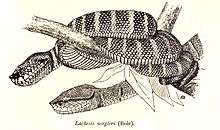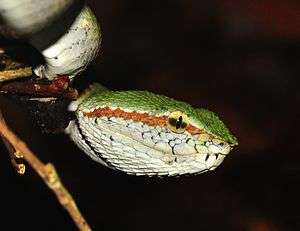Tropidolaemus wagleri
| Tropidolaemus wagleri | |
|---|---|
 | |
| Scientific classification | |
| Kingdom: | Animalia |
| Phylum: | Chordata |
| Subphylum: | Vertebrata |
| Class: | Reptilia |
| Order: | Squamata |
| Suborder: | Serpentes |
| Family: | Viperidae |
| Subfamily: | Crotalinae |
| Genus: | Tropidolaemus |
| Species: | T. wagleri |
| Binomial name | |
| Tropidolaemus wagleri (F. Boie, 1827) | |
| Synonyms | |
| |
Tropidolaemus wagleri is a venomous pitviper species native to South-East Asia. No subspecies are currently recognized.[4] It is sometimes referred to as the temple viper because of its abundance around the Temple of the Azure Cloud in Malaysia.
Etymology
The specific name, wagleri, is in honor of German herpetologist Johann Georg Wagler.[5]
Description

This species is sexually dimorphic: the females grow to approximately 1 m (39 1⁄4 in) in total length, while males typically do not exceed 75 cm (29 1⁄2 in). They have a large triangular-shaped head, with a relatively thin body. They are almost entirely arboreal, and the tail is prehensile to aid in climbing.
They are found in a wide variety of colors and patterns, often referred to as "phases". In the past, some researchers classified the different phases as subspecies. The phases vary greatly from having a black or brown coloration as a base, with orange and yellow banding to others having a light green as the base color, with yellow or orange banding, and many variations therein.

Common names
Wagler's pit viper, temple viper, temple pit viper,[3] bamboo snake, temple snake, speckled pit viper,[6] temple pitviper.[7]
Geographic range
Found in southern Vietnam from the provinces of Minh Hai and Song Be, in southern Thailand recorded from the provinces of Phang Nga, Pattani, Surat Thani, Nakhon Si Tammarat, Narathiwat, and Yala, probably distributed throughout the Peninsula in west Malaysia, as well as the island of Penang, in Singapore and in Indonesia on Sumatra, the islands of the Riau Archipelago, Bangka, Billiton, Nias, the Mentawai Islands (Siberut), Natuna, and Karimata.[8] "In a revision by Vogel et al. (2007) the Tropidolaemus wagleri species complex was differentiated into several taxa, including the resurrection of T. subannulatus. The Western Philippine populations belong to T. subannulatus, but those from Mindanao include snakes assigned to both this species and T. philippensis. Tropidolaemus subannulatus has a wide distribution in Central Indonesia, Malaysia and Philippines, T[ropidolaemus] wagleri is restricted to mainland Southeast Asia, down to Sumatra and Bangka, West Indonesia."[9]
Behavior
Nocturnal and arboreal, they appear quite sluggish as they remain motionless for long periods of time waiting for prey to pass by. When prey does pass by, or if disturbed, they can strike quickly.
Feeding
Their primary diet consists of rodents, birds, and lizards. The pits on the sides of the head between the eyes and nostrils are capable of detecting temperature difference of as little as 0.003 degree Celsius.[10]
Reproduction
Sexually mature females of T. wagleri bear live young by ovoviviparity. Litter size varies from 15 to 41.[11]
Venom
The venom of Tropidolaemus wagleri contains 4 novel peptides (Waglerins 1-4). The Waglerins produce fatal respiratory paralysis of adult mice.[12][13] An initial study indicated that micromolar concentrations of Waglerin 1 act both pre- and postsynaptically to inhibit transmission across rat neuromuscular junctions.[14] However, Waglerin-1 is a more potent inhibitor of transmission across the mouse neuromuscular junction.[15] A subsequent study demonstrated that Waglerin-1 inhibited the adult mouse endplate response to acetylcholine with an IC50 of 50 nanomolar. In striking contrast, transmission across neuromuscular junctions of neonatal or transgenic mice lacking the adult acetylcholine receptor was not altered by micromolar concentrations of Waglerin-1.[16] Biochemical studies demonstrated that the exquisite selectivity of Waglerin-1 for the adult mouse acetylcholine receptor relies upon several amino acid residues unique to the epsilon subunit of the adult mouse acetylcholine receptor.[17] Waglerin-1's selectivity for the epsilon-subunit containing acetylcholine receptor of adult mice is complemented by selectivity of small peptide toxins purified from the venom of Conus geographus and pergrandis for the gamma-subunit containing acetylcholine receptor of neonatal skeletal muscle.[18][19] The Waglerins and complementary conotoxins are useful tools to discover the contribution of acetylcholine receptor subunits to synaptogenesis.[20] In addition, study of the Waglerins and related toxic peptides may lead to the discovery of novel molecular targets for drug development. While Waglerin-1 interacts with other members of the ligand-gated superfamily of ion channels, the potency is much less than for inhibition of the adult mouse muscle acetylcholine receptor.[21][22] Structural study suggests that Waglerin-1 may undergo molecular rearrangement that allows for binding to multiple receptors.[23] The actions of Waglerin-1 reverse upon removal of the peptide.
Waglerin-1 is included in several skin creams marketed as wrinkle removers.[24][25] There is no scientific evidence supporting the manufacturers' suggestion that the Waglerin-1 included in their products relaxes wrinkle producing skeletal muscles.
Taxonomy
This species has undergone much taxonomic reclassification over the years and was previously placed in the genus Trimeresurus. However, their distinctly different morphology and venom characteristics set them apart, so that eventually a new genus was erected in which they were placed together with Hutton's viper, Tropidolaemus huttoni.
See also
- List of crotaline species and subspecies
- Crotalinae by common name
- Crotalinae by taxonomic synonyms
- Snakebite
References
- ↑ http://www.iucnredlist.org/details/192174/0
- ↑ McDiarmid RW, Campbell JA, Touré T. 1999. Snake Species of the World: A Taxonomic and Geographic Reference, Volume 1. Herpetologists' League. 511 pp. ISBN 1-893777-00-6 (series). ISBN 1-893777-01-4 (volume).
- 1 2 Mehrtens JM. 1987. Living Snakes of the World in Color. New York: Sterling Publishers. 480 pp. ISBN 0-8069-6460-X.
- ↑ "Tropidolaemus wagleri". Integrated Taxonomic Information System. Retrieved 25 May 2007.
- ↑ Bo Beolens; Michael Watkins; Michael Grayson (26 July 2011). The Eponym Dictionary of Reptiles. JHU Press. p. 278. ISBN 978-1-4214-0135-5.
- ↑ U.S. Navy. 1991. Poisonous Snakes of the World. US Govt. New York: Dover Publications Inc. 203 pp. ISBN 0-486-26629-X.
- ↑ Gumprecht A, Tillack F, Orlov NL, Captain A, Ryabov S. 2004. Asian Pitvipers. 1st Edition. Berlin: GeitjeBooks. 368 pp. ISBN 3-937975-00-4.
- ↑ Vogel, G., P. David, M. Lutz. van Rooijen & N. Vidal. 2007. Revision of the Tropidolaemus wagleri complex (Serpentes: Viperidae: Crotalinae). I. Definition of included taxa and redescription of Tropidolaemus wagleri (Boie, 1827). Zootaxa 1644: 1-40.
- ↑ Auliya, M., Dehling, M., Inger, R.F., Iskandar, D., Vogel, G., Diesmos, A.C. & Sy, E. 2012. Tropidolaemus subannulatus. The IUCN Red List of Threatened Species. Version 2015.2. <www.iucnredlist.org>. Downloaded on 30 August 2015.
- ↑
- ↑ Das, Indraneil. 2006. A Photographic Guide to Snakes and Other Reptiles of Borneo. Sanibel Island, Florida: Ralph Curtis Books. 144 pp. ISBN 0-88359-061-1. (Tropidolaemus wagleri, p. 58.)
- ↑ Weinstein SA, Schmidt JJ, Bernheimer AW, Smith LA (1991). "Characterization and amino acid sequences of two lethal peptides isolated from venom of Wagler's pit viper, Trimeresurus wagleri". Toxicon. 29 (2): 227–237. doi:10.1016/0041-0101(91)90107-3. PMID 2048140.
- ↑ Schmidt JJ, Weinstein SA, Smith LA (1992). "Molecular properties and structure-function relationships of lethal peptides from venom of Wagler's pit viper, Trimeresurus wagleri". Toxicon. 30 (9): 1027–1137. doi:10.1016/0041-0101(92)90047-9. PMID 1440639.
- ↑ Aiken SP, Sellin LC, Schmidt JJ, Weinstein SA, McArdle JJ (June 1992). "A novel peptide toxin from Trimeresurus wagleri acts pre- and post-synaptically to block transmission at the rat neuromuscular junction". Pharmacology Toxicology. 70 (6 Pt 1): 459–462. doi:10.1111/j.1600-0773.1992.tb00508.x. PMID 1359525.
- ↑ Tsai MC, Hsieh WH, Smith LA, Lee CY (March 1995). "Effects of waglerin-I on neuromuscular transmission of mouse nerve-muscle preparations". Toxicon. 33: 363–371. doi:10.1016/0041-0101(94)00158-5.
- ↑ McArdle JJ, Lentz TL, Witzemann V, Schwarz H, Weinstein SA, Schmidt JJ (September 1999). "Waglerin-1 Selectively Blocks the Epsilon Form of the Muscle Nicotinic Acetylcholine Receptor" (PDF). THE JOURNAL OF PHARMACOLOGY AND EXPERIMENTAL THERAPEUTICS. 289 (1): 543–550.
- ↑ Molles BE, Tsigelny I, Nguyen PD, Gao SX, Sine SM, Taylor P (June 2002). "Residues in the epsilon subunit of the nicotinic acetylcholine receptor interact to confer selectivity of waglerin-1 for the alpha-epsilon subunit interface site". Biochemistry. 41 (25): 7895–7906. doi:10.1021/bi025732d. PMID 12069578.
- ↑ Teichert RW, Rivier J, Torres J, Dykert J, Miller C, Olivera BM (January 2005). "A Uniquely Selective Inhibitor of the Mammalian Fetal Neuromuscular Nicotinic Acetylcholine Receptor" (PDF). Journal of Neuroscience. 25 (3): 732–736. doi:10.1523/JNEUROSCI.4065-04.2005. PMID 15659611.
- ↑ Teichert RW, Lopez-Vera E, Gulyas J, Maren Watkins M, Rivier J, Olivera BM (November 2006). "Definition and Characterization of the Short alphaA-Conotoxins: A Single Residue Determines Dissociation Kinetics from the Fetal Muscle Nicotinic Acetylcholine Receptor". Biochemistry. 45: 1304–1312. doi:10.1021/bi052016d. PMID 16430227.
- ↑ Teichert RW, Garcia CC, Potian JG, Schmidt JJ, Witzemann V, Olivera BM, McArdle JJ (June 2008). "Conformational Analysis of a Toxic Peptide from Trimeresurus wagleri which Blocks the Nicotinic Acetylcholine Receptor". Annals of the New York Academy of Sciences. 1132: 61–70. doi:10.1196/annals1405.015/.
- ↑ Ye JH, Ren J, McArdle JJ (August 1999). "Waglerin-1 inhibits GABA(A) current of neurons in the nucleus accumbens of neonatal rats". Brain Research. 837 (1-2): 29–37. doi:10.1016/s0006-8993(99)01668-6. PMID 10433985.
- ↑ Ye JH, McArdle JJ (March 1997). "Waglerin-1 modulates gamma-aminobutyric acid activated current of murine hypothalamic neurons". The Journal of Pharmacology and Experimental Therapeutics. 282 (1): 74–80. PMID 9223541.
- ↑ Sellin LC, Mattila K, Annila A, Schmidt JJ, McArdle JJ, Hyvonen M, Rantala TT, Kivisto T (January 1996). "Conformational Analysis of a Toxic Peptide from Trimeresurus wagleri which Blocks the Nicotinic Acetylcholine Receptor". Biophysical Journal. 70: 3–13. doi:10.1016/s0006-3495(96)79559-0.
- ↑ Pentapharm, Syn-Ake ||url=http://www.alivamax.com/docs/Syn-ake-Pentapharm.pdf
- ↑ Euoko, Y-30 Intense Lift Concentrate |url=http://www.euoko.com/
Further reading
- Boie, F. 1827. Bemerkungen über Merrem's Versuch eines Systems der Amphibien, 1te Lieferung: Ophidier. Isis von Oken 20: 508-566. (Cophias wagleri, p. 562.)
External links
| Wikimedia Commons has media related to Tropidolaemus wagleri. |
- Tropidolaemus wagleri at the Reptarium.cz Reptile Database. Accessed 12 December 2007.
- Ecology Asia page on Tropidolaemus wagleri
- Video of several species, including Tropidolaemus wagleri. on YouTube. Accessed 1 March 2007.
